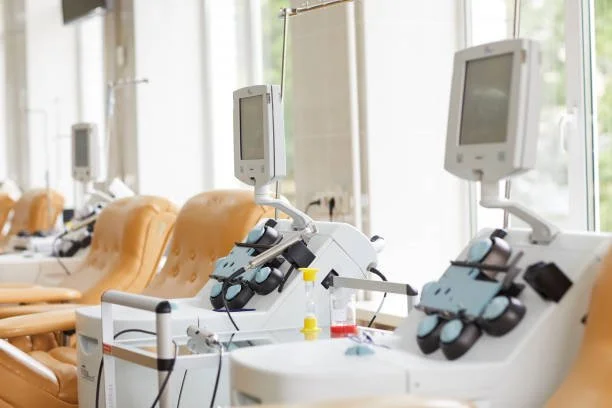Blood Bank
A blood bank is a specialized section within a hospital or a standalone facility where blood extracted from donors is stored, processed, and managed to be subsequently used in blood transfusions. The core functionalities of a blood bank include collecting, typing, separating, and holding various blood components such as plasma, red blood cells, platelets, and cryoprecipitate. Additionally, it assures the safety and quality of the blood, which will later be transfused into patients to save lives or improve medical conditions.
Why JIET Hospital
JIET Hospital recognized for its progressive approach to providing comprehensive healthcare, has remarkably expanded its services by incorporating an in-house blood bank. This pivotal step fortifies its medical preparedness and advocates for an integrated healthcare system, ensuring that safe and quality blood is available to patients whenever required.
The advent of the in-house blood bank in JIET Hospital addresses an essential component of healthcare delivery - timely and reliable access to blood, especially during emergencies. For a healthcare facility, where life-threatening situations like accidents, surgeries, and childbirth complications are frequently managed, an accessible and well-stocked blood bank can mean the difference between life and death.
Several factors set JIET Hospital’s blood bank apart and installed it as one of the best in the region.
Safety and Quality Assurance: JIET Hospital emphasizes rigorous testing and safety protocols to ensure the blood components are safe for transfusion.
Volunteer Donor Management: The hospital promotes a robust volunteer blood donation program, encouraging individuals to donate blood and save lives.
Technological Advancement: Employing cutting-edge blood testing, separation, and storage technology ensures optimal quality and safety.
Area of Specialization
Blood Component Separation: Employing state-of-the-art technology to separate blood into its components, ensuring the effective use of donated blood.
Transfusion Services: Offering specialized transfusion services for patients with various conditions requiring different blood components.
Hemovigilance: Monitoring and ensuring the adverse reactions of blood transfusion are minimized, and any occurrences are documented and analyzed.
Therapeutic Apheresis: Providing specialized procedures like plasmapheresis and plateletpheresis to cater to specific patient needs.
Blood Compatibility
Blood type compatibility is crucial for transfusions, organ transplants, and pregnancy. Blood types are categorized based on the presence or absence of antigens and antibodies. The main blood types in the ABO system are A, B, AB, and O; each can be either RhD-positive (+) or RhD-negative (-). Here's a basic table indicating which blood types can donate to and receive from others:
| Type | You can give blood to | You can receive blood from |
|---|---|---|
| A+ | A+, AB+ | A+, A-, O+, O- |
| O+ | O+, A+, B+, AB+ | O+,O- |
| B+ | B+, AB+ | B+, B-, O+, O- |
| AB+ | AB+ | EVERYONE |
| A- | A+, A-, AB+, AB- | A-, O- |
| O- | EVERYONE | O- |
| B- | B+, B-, AB+, AB- | B-, O- |
| AB- | AB+, AB- | AB-, A-, B-, O- |
Blood Components
Blood is a vital substance with a multifaceted role in the body, including the transportation of oxygen and nutrients, removal of waste, and involvement in immune responses. When donated, blood can be separated into various components with unique applications, especially in medical and emergency scenarios. Here’s a brief overview of the components :
| Services | Description |
|---|---|
| Whole Blood | Whole blood refers to the unseparated, complete blood collected from a donor. |
| Fresh Frozen Plasma (FFP) | FFP is the liquid portion of the blood that has been frozen quickly after donation to preserve clotting factors. |
| Platelet Concentrate (RDP) | Platelet concentrate refers to the separated platelets from donated blood. |
| Packed Red Cells (PRC) | PRC is obtained by removing as much plasma as possible from whole blood. |
FAQs
-
The general guidelines are anticipated to include age between 18 and 65, a weight above 50 kg, and good physical health. Individuals should not have engaged in risky behaviors that increase the likelihood of blood-borne infections.
-
Typically, it is estimated that males can donate every three months and females every four months to maintain optimum health and allow sufficient recovery time for the donor.
-
The envisioned procedure includes meticulous screening of the donors for any possible diseases or conditions that might make their blood unsafe for transfusion. The collected blood would be rigorously tested for various pathogens to ensure the utmost safety of the recipients.
-
In an imagined setting, the Blood Bank at JIET Hospital would maintain a robust inventory management system, ensuring that a significant stock of each blood type and component is readily available. Collaborations with other blood banks and a rapid response team would also be envisaged to facilitate quick replenishment in emergencies.




